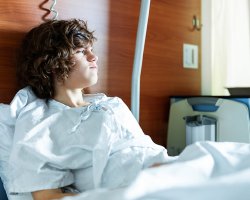How Could Hospitals Direct OD Patients to Treatment Centers?

Most of the time, when someone overdoses on drugs, they are taken to a hospital which treats the overdose. Of course, this is what happens when the addict is around someone who can call 911.
But what happens when the patient recovers from the overdose? The patient checks himself or herself out of the ER, leaves, and likely goes right back to using drugs. They will probably overdose again.
Why aren’t hospitals making a stronger effort to send their patients to rehab instead? What types of challenges do hospitals face in treating addicts? What policy could they implement that would make directing patients to treatment easier? Is this even possible?
The ugly truth? At this time, most addict-patients get up and walk out the hospital’s front door after a survived OD. Hospital staffers might not be technically or legally able to step in and physically prevent the addict from leaving. But hospital staff could be doing more to get addicts to seek treatment after they do survive an overdose.
The Standard Process
A brief article in U.S News goes over some of the intricacies of what really happens when a drug user overdoses.
First, the overdose occurs. An addict takes too much of their drug of choice, their body can’t handle the dosage, and the individual ODs. Then, a friend, family member, loved one, a fellow user, or a good Samaritan responds to the addict, calling 911 and hopefully applying naloxone (the overdose reversal drug).
If the overdosing addict doesn’t get naloxone from someone nearby, emergency medical responders will apply it as soon as they arrive on the scene. Once this is done and the addict-patient is stable, he or she is taken to the hospital so the medical team can be confident their patient is in a relatively safe medical condition.
EMTs never leave an ODed patient following the administration of naloxone. They always take them to the hospital, because something else could be wrong that the EMTs don’t have the equipment to diagnose.
According to the U.S. News article, the standard procedure of hospitals is to discharge patients recovering from an overdose within one to six hours of having received naloxone. Hospital staff will monitor the patients for a short while to determine they are “okay” and then send them on their way.
We know this because the Jacobs School of Medicine and Biomedical Sciences at the University at Buffalo, New York, performed a study of about 540 OD patients who went to various ERs and were treated. According to the research, most patients were observed on an average of four hours before being discharged.
The research says that patients only needed to be kept in the hospital for one to six hours because, after one hour of receiving naloxone, most patients’ vital signs were good. (The full research paper can be found at the Wiley Online Library. The U.S. News article provides a mere summary of a much more in-depth research report.)
“The landscape of opioid use disorder has changed dramatically. This rule (the one hour rule) is a way to predict which patients will have adverse outcomes after they overdose on opiates.…”
According to Dr. Brian Clemency, associate professor of emergency medicine and the study author, “The landscape of opioid use disorder has changed dramatically. This rule (the one hour rule) is a way to predict which patients will have adverse outcomes after they overdose on opiates. The rule is simple to follow and can be used by health care providers with varying levels of training and experience.”
This is pretty abhorrent, honestly. Dr. Clemency is talking about how his research justifies the standard practice of only keeping OD patients in emergency rooms for one to six hours, with the exact time kept in the ER being based off the patient’s vital signs after the one hour mark.
But what about the fact that the individual almost just died? What about the fact that the person just had a near-death experience and they might be finally ready and willing to get help if only someone would talk to them and intervene?
But intervention with the patients appears nowhere in standard policy for hospitals.
That needs to change.
The Hospital – An Untapped Potential for Intervention

They might not realize it, but hospitals are an ideal location for intervention. When an addict comes into the ER having just had a brush with death, he or she is most likely considering their predicament with the closest thing to a “wakeup call” that they’ll ever have.
This is the perfect time to sit down and have a heart-to-heart with the patient about getting help for their drug problem.
- Hospitals in addiction-rich environments could employ an in-house interventionist whose sole job is to work with patients who recently survived an overdose. Such an interventionist could talk with patients and attempt to convince them that there has never been a better time to get help than right now.
- Hospital staff could make it a part of their duties to speak with patients, urging them to seek help and cautioning them that, though they survived this overdose, they might not survive the next one. Hearing this news from a doctor could be all it takes to convince an addict to get help.
- Hospital staff could call around to local treatment centers and liaise with them, inviting representatives from those centers to come in and speak with patients. Such representatives could organize immediate transfer from the hospital to the treatment center.
- The family members of a recent OD patient could come in and see their loved one. With the team effort from the family (after some coaching from hospital staff perhaps), the family and the attendant doctor together could appeal to the patient’s sense of reason and judgment, making a bold suggestion for treatment over continuing drug use.
Some Organizations Are Working in the Right Direction
There is a silver lining here. Some organizations recognize the need for more help for OD patients. The Healthcare Business and Technology periodical wrote an article about what hospitals can do to help overdose patients. The article discussed many different things, focusing not only on overdose prevention but the subject of preventing prescription drug diversion as a whole.
The Pew Charitable Trusts organization featured in-depth coverage on a group of Maryland hospitals that are insisting on doing more for addict-patients. Led by Dr. Zachary Dezman, these hospitals seek to help addicts, not just treat them for overdoses.
As a side note, Dr. Dezman supports the use of medication-assisted treatments in treating recent OD patients, which is a poor route to travel. But just the fact that the Maryland hospitals recognize a need to do something more for patients is the right direction to take. They just need to focus their attention on getting addicts into treatment centers instead of using medications as a form of so-called “treatment.”
It’s going to be an uphill battle for some time, addressing the addiction epidemic that our great nation is mired in. But if hospitals jump on board in directing patients into addiction treatment centers, we could see change for the better on the addiction scene.
Sources:


 ®
®